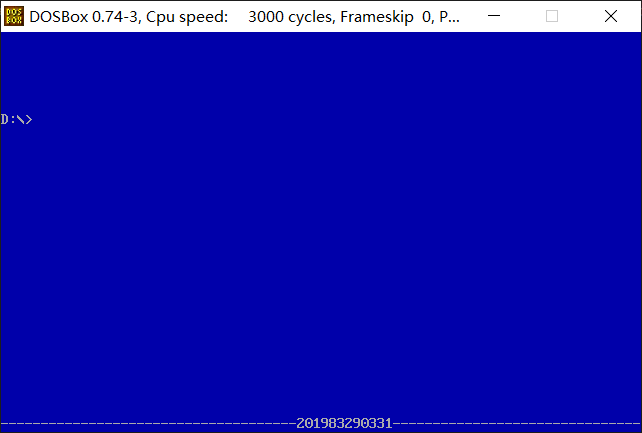1. Experimental task 1
Source code:
assume cs:code, ds:data data segment x db 1, 9, 3 len1 equ $ - x y dw 1, 9, 3 len2 equ $ - y data ends code segment start: mov ax, data mov ds, ax mov si, offset x mov cx, len1 mov ah, 2 s1:mov dl, [si] or dl, 30h int 21h mov dl, ' ' int 21h inc si loop s1 mov ah, 2 mov dl, 0ah int 21h mov si, offset y mov cx, len2/2 mov ah, 2 s2:mov dx, [si] or dl, 30h int 21h mov dl, ' ' int 21h add si, 2 loop s2 mov ah, 4ch int 21h code ends end start
Operation results:

① line27, when the assembly instruction loop s1 jumps, it jumps according to the displacement. Check the machine code through debug disassembly and analyze the jump displacement? (the displacement value is answered in decimal) from the perspective of the CPU, explain how to calculate the offset address of the instruction after the jump label s1.
In this command, the displacement is F2; Since it is in complement form, converting it to decimal number should be - 14.
First, the offset address of the instruction is 0019. According to the instruction length of the instruction, the CPU calculates that the offset address of the next instruction is 001B, and then subtracts the displacement from the offset address of the next instruction to obtain the jump offset address 000D.
② line44. When the assembly instruction loop s2 jumps, it jumps according to the displacement. Check the machine code through debug disassembly and analyze the jump displacement? (the displacement value is answered in decimal) from the perspective of the CPU, explain how to calculate the offset address of the instruction after the jump label s2.
In this command, the displacement is F0; Since it is a complement, converting it to decimal should be - 16.
First, the offset address of the instruction is 0037. According to the instruction length of the instruction, the CPU calculates that the offset address of the next instruction is 0039, and then subtracts the displacement from the offset address of the next instruction to obtain the jump offset address 0029.
③ Attach the disassembly screenshot of debugging observation in debug during the above analysis
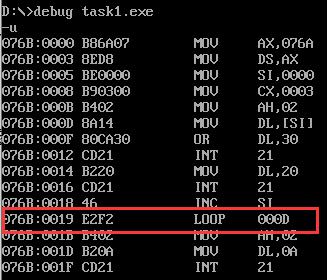
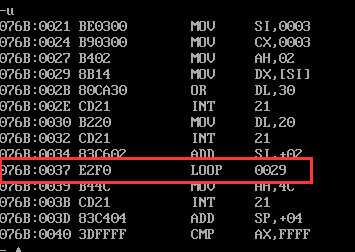
2. Experimental task 2
Source code:
assume cs:code, ds:data data segment dw 200h, 0h, 230h, 0h data ends stack segment db 16 dup(0) stack ends code segment start: mov ax, data mov ds, ax mov word ptr ds:[0], offset s1 mov word ptr ds:[2], offset s2 mov ds:[4], cs mov ax, stack mov ss, ax mov sp, 16 call word ptr ds:[0] s1: pop ax call dword ptr ds:[2] s2: pop bx pop cx mov ah, 4ch int 21h code ends end start
After analysis, debugging and verification, register (ax) =? (bx) = (cx) =? Attach the screenshot of the debugging result interface.
After the call is executed, the next instruction address of the current address will be implicitly stored in the stack;
The first call stores the offset address of s1 and assigns the address to AX through pop ax, so ax=offset s1=0021h
The second call successively stores the segment address and offset address of s2. First pop up the offset address through pop bx, so bx=offset s2=0026h; then pop cx pops up the segment address, so cx=code=076c
ax=0021,bx=0026,cx=076c
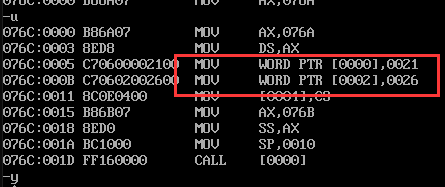

3. Experimental task 3
Source code
assume cs:code,ds:data data segment x db 99, 72, 85, 63, 89, 97, 55 len equ $- x data ends code segment start: mov ax,data mov ds,ax mov si,offset x mov cx,len s: call printNum call printSpace inc si loop s mov ax,4c00h int 21h printNum: mov ah,0 ;High position 0 mov al,[si] ;Number of bytes saved in low order ;Because only one character can be output at a time ;Therefore, divide the ten digits by 10 and output the quotient before outputting the remainder mov bl,10 div bl mov bx,ax mov ah,2 mov dl,bl ;The lower order stores the quotient, that is, ten digits or dl,30h ;Converting numbers to characters is equivalent to adding 48 int 21h mov ah,2 mov dl,bh ;The high bit holds the remainder, that is, one bit or dl,30h int 21h ret printSpace: mov ah,2 mov dl,32 int 21h ret code ends end start
Operation results:

4. Experimental task 4
Source code:
assume cs:code,ds:data data segment str db 'try' len equ $ - str data ends code segment start: mov ax,data mov ds,ax mov ax,0b800h ;es Play memory mov es,ax mov cx,0 mov bh,0 ;bh Specify row mov bl,2h ;bl String color,Green characters on black background call printStr mov bh,24 mov bl,4h ;Scarlet letter on black background call printStr mov ax,4c00h int 21h printStr: mov si,offset str ;String start offset address mov cx,len ;String length mov ah,0 mov al,bh ;ax Save specified row in mov dx,160 ;160 bytes per line mul dx ;Calculates the starting offset address of the specified row mov di,ax ;mul 8 Bit results will be placed in ax in s: mov al,[si] ;Put it low first and save characters in low order mov es:[di],al mov es:[di+1],bl ;High level amplification attribute add di,2 inc si ;Move to next character loop s ret code ends end start
Operation results:
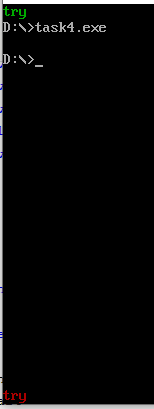
5. Experimental task 5
Source code:
assume cs:code,ds:data data segment stu_no db '201983290331' len = $ - stu_no data ends code segment start: mov ax,data mov ds,ax mov ax,0b800h ;es Video memory address mov es,ax mov bx,1700h call printCol ;Line 25 starts with an offset address of 3840 ;24*80=1920 word =3840 byte mov si,3840 mov cx,160 ; call printLine ;len=12 mov si,3914 ;3840+(160-12)/2 mov cx,12 call printNum mov ax,4c00h int 21h printCol: mov si,0 mov cx,4000 ;25*80*2 byte s: mov es:[si],bl mov es:[si+1],bh add si,2 loop s ret printLine: mov bh,17h mov bl,2dh s1: mov es:[si],bl mov es:[si+1],bh add si,2 loop s1 ret printNum: mov di,0 s2: mov bl,[di] mov es:[si],bl mov es:[si+1],bh add si,2 inc di loop s2 ret code ends end start
Operation results:
